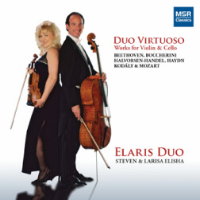
Virtuoso Duo
Performances by
the Elaris Duo -
recommended by
MALCOLM TATTERSALL'... all the passion, drama and integrity one could want.'
|

|
Larisa and Steven Elisha ask for a lot of respect by calling their disc 'Duo Virtuoso', but they begin earning it from the first bar of the first item:
Listen -- Mozart: Allegro (Duo in G)
(track 1, 0:01-0:52) © 2008 MSR Classics
Their commitment, authority, grace and buoyant energy are evident throughout this splendid Mozart Duo (K 423) and the rest of their programme.
Received wisdom has it that 'real' chamber music is the string quartet, with the string trio being inevitably lightweight in comparison and duos not even worth considering -- which is a bit odd when you think about it, since it is simultaneously acknowledged that works for a single string instrument can be masterpieces. (Bach Cello Suites, anyone?) By now, of course, received wisdom has become a self-fulfilling prophecy. Composers have neglected duos and trios because they will get few performances because ensembles don't exist because venues aren't interested, and all because they would get no respect because of received wisdom! Perhaps the Elaris Duo can begin to undermine the prejudice.
They follow the Mozart with music of Boccherini, Haydn, Beethoven, Halvorsen and Kodály. Not all of it was originally for violin and cello. The Mozart and Halvorsen pieces were both written for violin and viola but remain completely convincing in transcription, while the Beethoven was transcribed from WoO 27 for clarinet and bassoon. And not all of it is complete, since a single Allegro by Boccherini is paired (seamlessly, I must say) with an Adagio from a Haydn sonata in the same key. Here is Boccherini:
Listen -- Boccherini: Allegretto spiritoso (Sonata in D)
(track 4, 0:00-0:24) © 2008 MSR Classics
It is very pleasant but never develops beyond amiability and the same could be said of the Haydn.
Most readers, I'm sure, know about the 'K' numbers for Mozart, the 'BWV' numbers for Bach, and others: simply catalogue numbers. 'WoO' is less well known, because it catalogues only the works Beethoven did not dignify with an Opus number -- mostly early works, trivia and a sprinkling of works of dubious authenticity. WoO 27, in fact, is listed as 'probably spurious' in my not-very-New Grove. Listening to it again after making that discovery crystallised my prior doubts about it: it doesn't even convince me as a piece that could have been written for clarinet and bassoon, ie, the original publication may have been a transcription (from piano?) as well as wrongly attributed to Beethoven. It's very much of the period, though, and it's well crafted: if it isn't early Beethoven, one might guess Spohr or Clementi. What do you think?
Listen -- Beethoven: Allegro comodo (Duo, WoO 27)
(track 6, 3:34-4:46) © 2008 MSR Classics
Halvorsen's Passacaglia after Handel, composed in 1894, may have been inspired partly by Brahms' 1861 set of Variations. It is a very Romantic virtuoso showpiece securely underpinned by the repeated eight-bar sequence of its Baroque source:
Listen -- Halvorsen, after Handel: Passacaglia
(track 9, 3:59-4:51) © 2008 MSR Classics
Nearly seven minutes long, the Halvorsen approaches the total length of the Beethoven which precedes it but is dwarfed by the final work. Kodály's Duo for Violin and Cello, Op 7 (1914), is a major work in three movements totalling about 25 minutes and with all the passion, drama and integrity one could want.
Listen -- Kodály: Allegro serioso, non troppo (Duo, Op 7)
(track 10, 4:00-6:04) © 2008 MSR Classics
The work owes much to the Hungarian folksongs Kodály had been collecting with Bartók in the decade before it was composed. Genuine traditional melodies are integrated into it, and its harmonies are often based on ethnic modes. But it is firmly grounded in the Beethoven-Brahms tradition and also owes something to Debussy's impressionism, particularly in the second movement.
Listen -- Kodály: Adagio (Duo, Op 7)
(track 11, 4:10-5:49) © 2008 MSR Classics
To return to my earlier theme: the Boccherini, Haydn and 'Beethoven' duos are comparatively lightweight, but so are many of the quartets of that period. Mozart shows that a duo is not necessarily inferior to a quartet, and Kodály proves it again a hundred and thirty years later.
To return to my earliest theme: 'Duo Virtuoso' is shown to be a perfectly appropriate title for the disc; I'll turn it around, too, and call the performers a virtuoso duo. Highly recommended.
Copyright © 28 April 2009
Malcolm Tattersall,
Townsville, Australia
 CD INFORMATION: DUO VIRTUOSO - WORKS FOR VIOLIN AND CELLO
CD INFORMATION: DUO VIRTUOSO - WORKS FOR VIOLIN AND CELLO
LUDWIG VAN BEETHOVEN WOLFGANG AMADEUS MOZART JOHAN HALVORSEN GEORGE FRIDERIC HANDEL
| 
